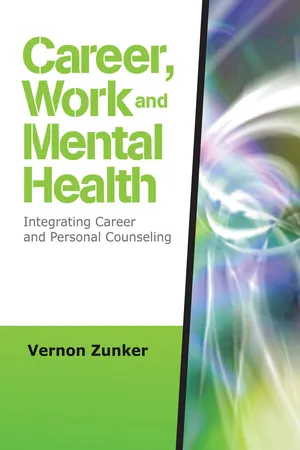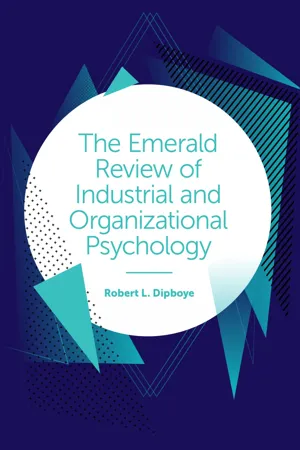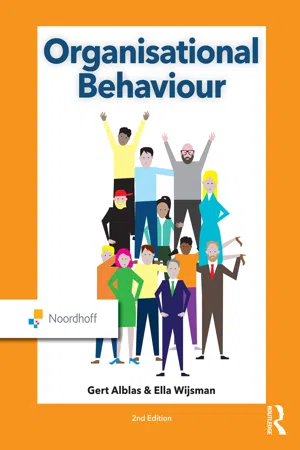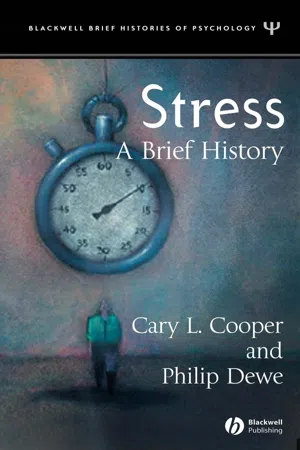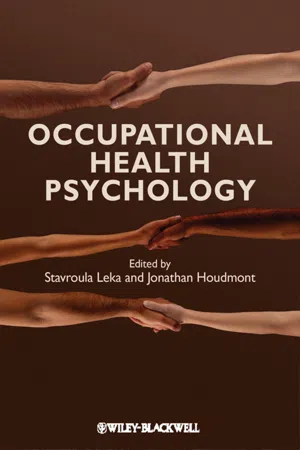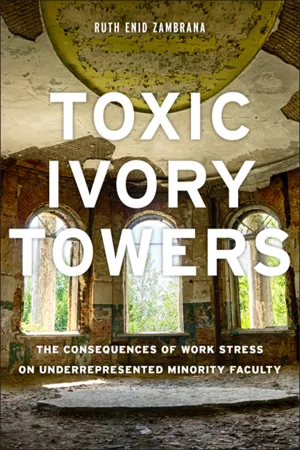Psychology
Workplace Stress
Workplace stress refers to the emotional, physical, and mental strain experienced by individuals in their work environment. It can result from factors such as heavy workloads, tight deadlines, and interpersonal conflicts. Chronic workplace stress can lead to burnout, decreased productivity, and negative impacts on overall well-being. Employers often implement strategies to mitigate workplace stress and promote a healthier work environment.
Written by Perlego with AI-assistance
Related key terms
1 of 5
10 Key excerpts on "Workplace Stress"
- No longer available |Learn more
Career, Work, and Mental Health
Integrating Career and Personal Counseling
- Vernon Zunker(Author)
- 2008(Publication Date)
- SAGE Publications, Inc(Publisher)
Work Stress 195 11 W ork stress has been the topic of numerous research projects over sev-eral decades. The concerns surrounding work stress appear to be well founded. In 1999, for instance, it was estimated that 550 million work-ing days were lost annually in U.S. industries because of stress-related absen-teeism (Danna & Griffin, 1999). The pervasive nature of work-related stress may also be responsible for negative reactions to the workplace and/or to other employees and supervisors, and it has been known to promote poor job performance (Sulsky & Smith, 2005). In addition, health concerns such as gastrointestinal problems and cardiovascular disease have been associated with work stress, particularly shift work (G. Costa, 1996). Serious concerns over the health of the workforce have become a significant issue of the 21st century. In 1991, for example, almost 72% of workers in a national survey reported that they had experienced frequent stress-related problems (Muchinsky, 2003). Like the previous chapter, this chapter focuses on developing an under-standing of the interplay of influences that leads to symptoms of work stress. In the process of discovery helpers must recognize that many events in life can be stress related: First day in school, meeting new friends, prepping for an exam, and starting a new job are examples of stress-related events. The point here is that people face stress-related activities in almost all dimensions of their lifestyle; therefore, stress in the workplace consists of stressors that originate from multiple sources of experiences. Understanding the whole person as a member of a complex social system is a challenge for all helpers. In the pages that follow, however, the focus is on the work role, which for most individuals is a pervasive part of human existence. A person’s work role is often at the center of his or her life story. - Robert L. Dipboye(Author)
- 2018(Publication Date)
- Emerald Publishing Limited(Publisher)
An essential component of stress is that external events impose demands greater than the individual can handle. The perceived demands are as important as the actual demands. In dealing with the demands posed at work and outside of work, the individual falls back on behavioral, social, cognitive, and affective resources. An employee faced with a difficult and complex task assignment could draw from the knowledge and skills he has accumulated from past work experiences, seek aid and assistance from coworkers, supervisors, and family, and mobilize cognitive and personality traits useful to performing the task (e.g., apply his reasoning abilities, high need for achievement, and emotional stability). Stress occurs when the people believe their resources fall short of the demands.Stress as defined and studied by scientists is a complex set of interrelated antecedents, mediators, moderators, and consequences. Stress refers to the total package of outside events triggering stress, the physiological, affective, and behavioral responses to these events, and the strains or long-term consequences. A useful framework for thinking about work stress is the Transactional Process Model.A Transactional Process Model of Stress
The Transactional Process Model is arguably the most influential approach to understanding work stress (Lazarus & Folkman, 1984; Schuler, 1982, 1985). Fig. 5.1 is a variation on this model. In the first step of the process, a cognitive appraisal is made of stressors. In this assessment, employees evaluate the threat posed by negative events or stimuli, the extent to which the work environment fulfills their needs, whether their resources are sufficient to deal with present and future threats, and whether they have sufficient control and social support. In coping with stress, four general approaches are distinguishable. The individual can focus on solving the problem by dealing with the sources of the stress. They can attempt to reduce the anxiety and other emotions associated with the stress. They can reappraise the stressors as less threatening or ignore them. Finally, they can change the behaviors contributing to the stress.The model pulls together all the components of the stress experience and focuses on the interactive and reciprocal relations among these components. The model is integrative in organizing and reconciling a large, diverse body of research findings. Transactional means the relationships in the model are reciprocal. In other words, each variable in the model is a cause of other variables and is, in turn, an effect or outcome. Process indicates that the relations in the model unfold over time and are subject to mediation and moderation.- eBook - PDF
- Gert Alblas, Ella Wijsman(Authors)
- 2021(Publication Date)
- Routledge(Publisher)
10.1.1 Stress at work Stress relates to the pressure a person experiences. Perceived pressure Stress causes tension. The body reacts to tension by increasing physiological activity. When this does not result in lowering the tension and the physiological activity persists, exhaustion will result. Resistance to pressure declines and the risk of physical and psychological ill-health increases. Stress at work occurs if a person cannot satisfy the demands of their work. The characteristics of the work or work situation that can cause stress are called stressors.The first example shows how Sandy is continually pressed Stressors for time and never has the feeling that she has her work under control. The stress evoked by this situation causes her headaches, stomach pains and sleeplessness. Not all pressure leads to stress in employees. One person can take more than another and some people thrive under pressure. In a department where everyone has to deliver the same high performance and therefore has the same work load, one employee will experience more stress than another. Work load The effect is related to the extent to which a person can handle the pressure Capacity put upon him. Someone’s capacity or load tolerance is determined by their ability to prevent and cope with stress. A person will experience stress at Recovery time work if there is too little recovery time and if the balance between work load Balance and capacity is seriously or protractedly upset. The perceived pressure will Stress reactions then result in stress reactions (see Figure 10.1). © Noordhoff Uitgevers bv 360 10 FIGURE 10.1 Causes and consequences of tension at work Stressors at work Stress Inadequate recovery time Burden is higher than potential Stress reactions NRC Handelsblad Half of police force under constant stress Half of the 50,000 policemen and women in the Netherlands as suffering from stress- related complaints, says an internal study commissioned by Dutch National Police. - eBook - PDF
Stress
A Brief History
- Cary Cooper, Philip J. Dewe(Authors)
- 2008(Publication Date)
- Wiley-Blackwell(Publisher)
CHAPTER FIVE Work Stress and Occupational Health Psychology Introduction In their seminal article on job stress and employee health, Beehr and Newman (1978) commented that as most people spend around half their waking lives at work, then it is more than likely that work factors will have an important influence on their well-being. A rich history of work stress was already in the making by the time Beehr and Newman wrote their article. The work stress research that began to appear in the 1950s and 1960s, was simply following a tradition that had its roots in the work on fatigue and mental hygiene, was molded by the requirements of two World Wars, and reflected changes in social and economic circum-stances that created considerable opportunities for applied psy-chological research at work. The decades immediately after World War II reflected a spirit of optimism and innovation, but they were also marked by periods of industrial unrest and con-flict (Cooper et al., 2001). The organizational culture that was to emerge from this time soon had commentators talking of the stresses and strains at work, and a need to systematically investi-gate the consequences of work-related stress. Work Stress By 1959, a research program exploring the work environment and mental health had been set up at the Institute for Social Research at the University of Michigan. However, even before this program had begun Zander and Quinn (1962) were able to find 75 studies that the Institute had been involved in, since 1948, that ‘‘contained empirical findings and theoretical speculations relevant to problems of mental health’’ (Kahn and French, 1962, p.122). While these studies became the research ancestry of the program begun in 1959, they had really only scratched the sur-face of the problem in a variety of contexts. - eBook - PDF
- Athel Cornish-Bowden, Cary Cooper(Authors)
- 2004(Publication Date)
- CRC Press(Publisher)
Stress reactions result from the individual’s appraisal of a contextual factor. In addition, employees differ in the way they address stressful work factors (the concepts of active or passive coping). So there is little doubt that stress is indeed an individual phenomenon. To illustrate the role of individual differences, there is the saying that “One man’s meat is another man’s poison.” Indeed, there are large differences between people — differences in personality characteristics, experience, ambitions, and knowledge, skills, and abilities. There are also differences within people: the same “objective” task might be more demanding for someone when he is a freshman than — after a couple of years — when he has become a more experienced employee. Also, when fatigued, the same “objective” task demand is assessed as more demanding than when the employee is not fatigued. Let us consider the examples of mountaineering and lion taming. It is true that some people are fond of climbing mountains or taming wild animals (“One man’s meat is another man’s poison”). We should, however, bear in mind that statistically these are minorities, and that for most persons these activities would be very stressful. The same reasoning applies to the psychosocial work environment. It is true that not all employees prefer skill variety, and it is true that there are people who prefer to work in splendid isolation. But we should not forget that most employees do like to use their skills and to communicate and cooperate with others. In this chapter we have therefore chosen a probabilistic conceptualization of stressors; i.e., certain work characteristics are de fi ned as risk factors when they tend to elicit stress reactions in “most people most of the time, regardless of circumstances” (Sauter et al., 1998, pp. 34.2–34.3). - eBook - PDF
- Stavroula Leka, Jonathan Houdmont, Stavroula Leka, Jonathan Houdmont(Authors)
- 2010(Publication Date)
- Wiley-Blackwell(Publisher)
Introduction The potential impact of work-related factors on the psychological and physical health and well-being of workers has been clearly established in research spanning more than 50 years, along with the notion that individuals and organizations share a responsibility to optimize well-being. To achieve this optimization, it is essential to examine the range of factors which may significantly contribute to physical health and psychological well-being, to determine the influence which . . . . . . . . . . . . . . . . . . . . . . . . . . . . . . . . . . . . . . . . . . . . . . . . . . . . . . . . . . . . . . . . . . . . . these exert and, most importantly, to ascertain how work-related factors may be manipulated to ensure that at the very least they are not harmful to individual workers, and ideally that they make a positive contribution to their health and well-being. The aim of the present chapter is to provide an overview of some of the more common work-related predictors of physical health and psychological well-being and to summarize conclusions which have been drawn from research on these variables. Above we introduced the concepts of ‘hazards’ and ‘stressors’, both of which have been used in the stress and well-being literature. These terms refer to occurrences or events which individuals are exposed to which may threaten their health or well-being. The concept of hazard derives from the literature on risks and risk management, whereas the term stressor is more closely aligned with theoretical models of stress and stress management (including coping). For present purposes, however, they are functionally equivalent and (for simplicity) we will use the expression ‘stressors’ when describing stimuli which have the potential to generate negative outcomes for individuals. The chapter focuses on two major issues: types of stressors and types of people who are likely to experience these stressors. - eBook - PDF
Coping with Work Stress
A Review and Critique
- Philip J. Dewe, Michael P. O'Driscoll, Cary Cooper(Authors)
- 2010(Publication Date)
- Wiley-Blackwell(Publisher)
International Journal of Stress Management 14(3): 227–48. Hauge, L. J., Skogstad, A. & Einarsen, S. (2007) Relationships between stressful work environments and bullying: Results of a large representative study. Work & Stress 21(3): 220–42. Haward, L. R. C. (1960) The subjective meaning of stress. British Journal of Psychol- ogy 33: 185–94. Hayman, A. (2008) Major job losses forecast for all of England. Regeneration & Renewal 7th November, http://www.regen.net/news/EmailThisArticle/ 859991/. Health & Safety Commission (2000) Securing Health Together: A long term occu- pational health strategy for England, Scotland and Wales. London: Health and Safety Executive. Health and Safety Executive (2005) Psychosocial Working Conditions in Great Britain 2005. London: HSE. Health and Safety Executive (2006) Stress-Related and Psychological Disorders. London: HSE. Health and Safety Executive (2007a) Violence at Work. London: HSE. Health and Safety Executive (2007b) Self-Reported Work-Related Illness and Work- place Injuries in 2005/06: Results from the Labour Force Survey. Caerphilly: HSE Information Services. Health and Safety Executive (2007c) Self-Reported Work-Related Illness or Work- place Injury. London: HSE. Heintzman, P. & Mannell, R. C. (2003) Spiritual functions of leisure and spiritual well-being: Coping with time pressure. Leisure Sciences 25: 207–30. References 173 Hemp, P. (2004) Presenteeism: At work – but out of it. Harvard Business Review 49–58. Hill, D., Lucy, D., Tyers, C. & James, L. (2007) What works at work? Review of evi- dence assessing the effectiveness of workplace interventions to prevent and manage common health problems. Leeds: Corporate Document Services, pp. 1–87. Hobfoll, S. E. (1989) Conservation of resources: A new attempt at conceptualizing stress. American Psychologist 44: 513–24. Hobfoll, S. E. (1998) Stress, Culture and Community: The psychology and philosophy of stress. - eBook - PDF
Toxic Ivory Towers
The Consequences of Work Stress on Underrepresented Minority Faculty
- Ruth Enid Zambrana(Author)
- 2018(Publication Date)
- Rutgers University Press(Publisher)
Chronic daily stressors are associated with physiological imbal- ance and dysfunction that can contribute to physical breakdown and mental stress (Brondolo et al., 2009; Brondolo et al., 2012) Exacerbating the effects of daily Workplace Stress was that stressful life events outside the workplace, such as restricted economic resources and adverse family events, had a significant impact. Workplace Stressors are compounded by obligations that many par- ticipants reported with familial connections and responsibilities to family of origin and extended and fictive kin (Heflin & Pattillo, 2006; Higginbotham & Cannon, 1992; Vallejo, 2012). These relationships oftentimes involve additional emotional labor and economic outputs that can increase an already stressful set of work-related experiences. Furthermore, these findings lend support to prior anecdotal and narrative data (Agathangelou & Ling, 2002; Gutiérrez y Muhs, Niemann, González, & Harris, 2012; Medina & Luna, 2000; Smith & Calasanti, 2005) and recent empirical findings of an inverse relationship between health advantage and higher education level for Black and Latino URMs (Dinwid- die et al., 2014; Dinwiddie, Zambrana, Doamekpor, & Lopez, 2016; Schieman et al., 2006). This study is one of the first to provide insight into the ways in which social status and Workplace Stress contribute to the inverse relationship between edu- cational and occupational advantage and physical and mental well-being. These data proffer an interpretive lens for extending our understanding of vocational strain as encompassing multiple domains: institutional, family, economic, and social status. Social status racial/ethnic effects (devaluation, disrespect, inequi- table access to opportunity and resources; Ridgeway, 2014) and a life course lens are particularly important for explaining how social status shapes economic and social opportunity. - eBook - PDF
- Michael A. Hitt, C. Chet Miller, Adrienne Colella, Maria Triana(Authors)
- 2017(Publication Date)
- Wiley(Publisher)
Those who remain on the job experienced stress before the layoff decision (because of uncertainty about who would be laid off), experienced the loss of friends and co-workers who were laid off, and must endure added pressures to accomplish tasks with fewer workers. Working Conditions The job environment can have major effects on job attitudes and reactions. The job envi- ronment includes both physical surroundings (lighting, temperature, noise, office arrange- ments, and so on) and psychological aspects (such as peer relationships, warmth, and perceived rewards). If the working conditions are unpleasant, they can be stressful. For example, working with inadequate lighting, loud noise, or uncomfortable temperatures, or working in isolation from others, creates pressure and stress. 52 Management Style Management style significantly affects the psychological climate of the workplace, and certain styles of dealing with subordinates create more stress than others. For example, one study found that high scores on Machiavellianism (managing through fear) were negatively related to job satisfaction and positively related to job tension. 53 Certain types of jobs and associate personalities may interact with managerial style to produce stress. For example, Organizational and Work-Related Stressors 229 directive managerial styles may produce less stress on routine jobs and with associates who prefer a more structured environment. However, for people in professional jobs and for those who prefer more personal involvement and self-determination in their jobs, a less directive managerial style produces less stress. Monitoring Relatively recent developments in technology have led to an explosion of stricter moni- toring of associates’ behavior—both work-related and non-work-related. Organizations are able to read associates’ e-mail, detect websites they visit, listen to phone conversations, and keep track of any work they do electronically. - eBook - PDF
- Ana Maria Rossi, James A. Meurs, Pamela L. Perrewé(Authors)
- 2015(Publication Date)
- Information Age Publishing(Publisher)
Both organizations and national economies experience huge costs as a re- sult of stress and mental health disorders. For example, it is estimated that stress costs the U.S. economy $300 billion annually with similarly astronomi- cal estimates derived from the United Kingdom, Canada ($50 billion annu- ally, Mental Health Commission of Canada, 2012) and the European Union (135 million euro annually for depression, McDaid, 2011). Given these figures, it is not surprizing that a great deal of research has accumulated on the causes of stress and numerous taxonomies of stressors exist (for a review see Kelloway & Day, 2005). Although such taxonomies are useful in identifying possible sources of distress in the workplace, the focus on stressors as aversive experiences has created a paradox in the stress literature. The paradox emerges because individuals frequently agree to expose themselves to enhanced levels of Workplace Stress. For example, although we know that workload is a stressor we also know that many in- dividuals have a seeming inability to say “No,” and as a result take on an enhanced workload. I suggest that any theory of stress must be able to ex- plain this paradox, accounting for both the aversive nature of stress and individual motivation to take on stressful tasks. Contemporary accounts of the stress process resolve this paradox by rec- ognizing that the workplace exposes individuals to both stressors (i.e., de- mands) and resources (e.g.., Bakker & Demerouti, 2007). Demands require physical and/or psychological effort from employees, and are associated with both physical (e.g., fatigue) and psychological (e.g., burnout) con- sequences. Employees also experience resources—aspects of the job that help them deal with demands, and promote personal growth and well-be- ing (Bakker & Dermerouti, 2007).
Index pages curate the most relevant extracts from our library of academic textbooks. They’ve been created using an in-house natural language model (NLM), each adding context and meaning to key research topics.
